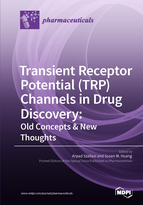Transient Receptor Potential (TRP) Channels in Drug Discovery: Old Concepts & New Thoughts
A special issue of Pharmaceuticals (ISSN 1424-8247).
Deadline for manuscript submissions: closed (1 June 2016) | Viewed by 144050
Special Issue Editors
Interests: the capsaicin receptor TRPV1; small molecule TRP inhibitors; TRP channels and cancer; neurogenic inflammation and cancer; cancer pain
Special Issues, Collections and Topics in MDPI journals
Special Issue Information
Dear Colleagues,
Next year will mark the 20th anniversary of the 1997 molecular cloning of the vanilloid (capsaicin) receptor TRPV1. This seminal finding has opened up a new chapter in drug discovery efforts and initiated an unprecedented investment by pharma into drug development. Indeed, the first TRPV1 antagonists were ushered into clinical trials with record speed where most flamed out to great disappointment due to a combination of unforeseen side-effects and lack of clinical efficacy. Meanwhile, other TRP channels have emerged as promising therapeutic targets. At present, TRPA1 (pain, cough), TRPV3 (pain), and TRPM8 (prostate cancer) are being tested in patients, and other TRP channels are probably not far behind. To review twenty years of relentless progress in the TRP channel field, the journal Pharmaceuticals now invites both review articles and originals findings. Invited reviews are listed below. This collection of manuscripts will be published as a Special Issue in the journal first, and hopefully as an eBook later on. Please, email either Susan Huang or Arpad Szallasi if you would like to contribute a paper to this TRP channel issue.
Dr. Arpad Szallasi
Guest Editor
Dr. Susan M. Huang
Co-Guest Editor
Manuscript Submission Information
Manuscripts should be submitted online at www.mdpi.com by registering and logging in to this website. Once you are registered, click here to go to the submission form. Manuscripts can be submitted until the deadline. All submissions that pass pre-check are peer-reviewed. Accepted papers will be published continuously in the journal (as soon as accepted) and will be listed together on the special issue website. Research articles, review articles as well as short communications are invited. For planned papers, a title and short abstract (about 100 words) can be sent to the Editorial Office for announcement on this website.
Submitted manuscripts should not have been published previously, nor be under consideration for publication elsewhere (except conference proceedings papers). All manuscripts are thoroughly refereed through a single-blind peer-review process. A guide for authors and other relevant information for submission of manuscripts is available on the Instructions for Authors page. Pharmaceuticals is an international peer-reviewed open access monthly journal published by MDPI.
Please visit the Instructions for Authors page before submitting a manuscript. The Article Processing Charge (APC) for publication in this open access journal is 2900 CHF (Swiss Francs). Submitted papers should be well formatted and use good English. Authors may use MDPI's English editing service prior to publication or during author revisions.
Keywords
- TRP channels
- capsaicin
- resiniferatoxin
- TRPV1
- TRPV3
- TRPA1
- TRPM2
- TRPM7
- TRPM8
- pain
- permanent analgesia
- diabetes
- obesity
- cancer
- respiratory disorders








